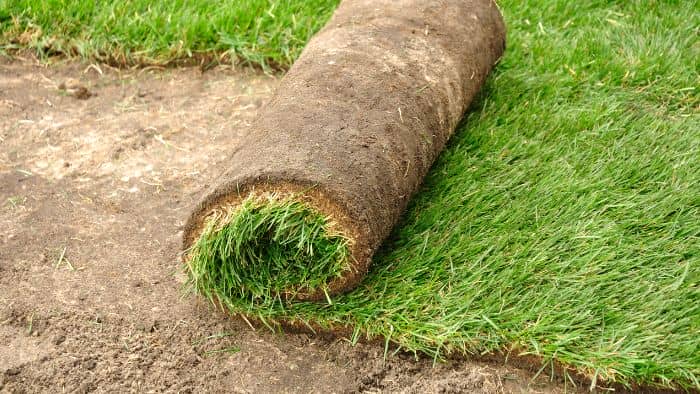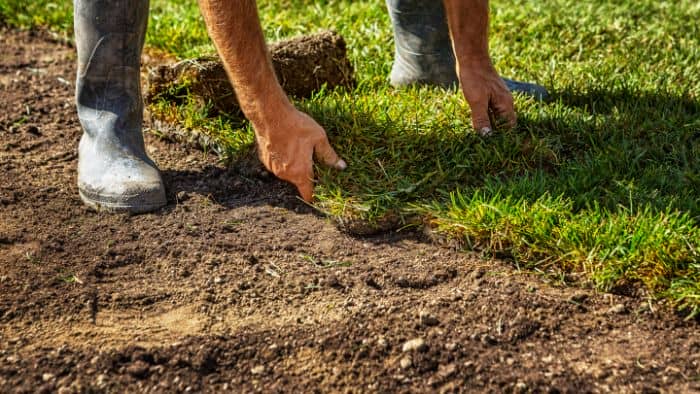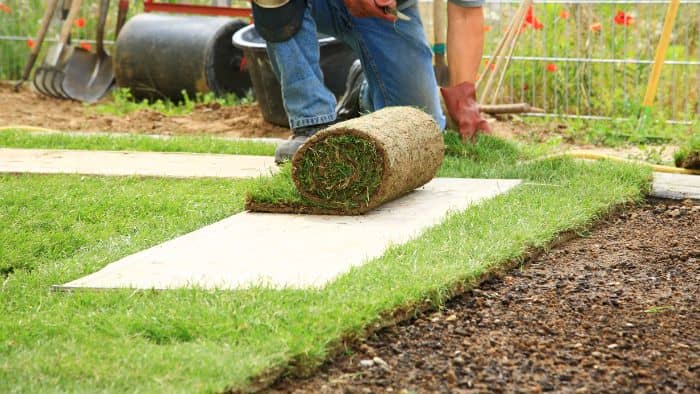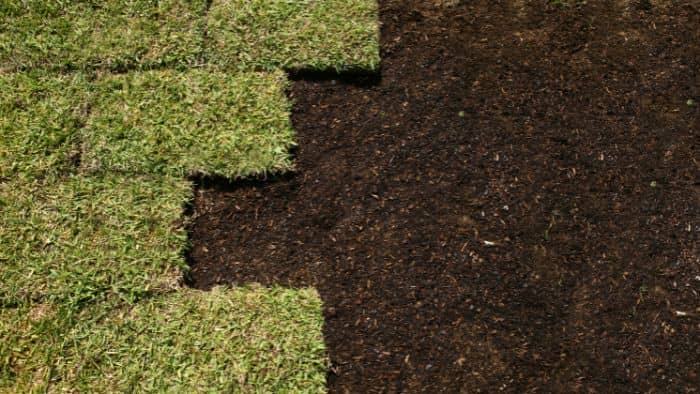Knowing what is the Best Soil for Sod will afford you a lush lawn in minimal time. As a speedier option than starting a lawn from scratch, sod is often used to restore dead grass patches, golf courses, or athletic fields. It is also quite useful for enhancing the quality of the air and water in your garden and draining water.
For slopes or prone to erosion regions where seeds would struggle to grow, sod is a fantastic option. However, the only drawback is that only specific grass species are grown for sodding, which limits your options. But, no matter which one you choose to grow, using nutrient-rich soil is crucial for their health.
Opting for a sod lawn will give you a beautiful, instantly green landscape. With the best growing medium, maintenance, and care, these delicate transplanted carpets will grow roots quickly and thrive. Here are some ideas for maintaining your lush green grass.
How To Prepare Soil For Sod
The preparation of the soil is essential whether an area is being seeded or sodded. A well-prepared site will make upkeep easier in the future and ensure a healthier lawn. A dying patch of grass or other vegetation can be transformed into an attractive yard by adding this type of carpeted grass. Using the best soil for sod is recommended as it will ensure an even and healthy-looking matted outdoor appearance.
1. Soil Test
You can use a soil test kit to determine what you should add to make it healthy and ready for sod. Before testing, ensure that you randomly select soil from various locations where you plan on planting your grass. The soil pH levels should tell you if it needs amending.
2. Debris Removal
Thereafter, remove any debris from the soil which includes dispersed branches, rocks, leaves, and weeds. This is because large objects should not be placed on top or under your sod since they may hinder its growth and leave a bumpy, uneven finish.

3. Using a Herbicide
It is essential to utilize a nonselective herbicide to eradicate undesired grass and weeds. It is simpler to control these unwanted invaders if you tackle them before the sod is laid. Apply the herbicide in accordance with the package directions a month before you intend to start planting.
4. Leveling the Ground
Any peaks or mounds in the ground should be leveled. Break up the soil’s high points with an iron rake or shovel. Spread the broken-up earth around to level the area with the surrounding soil.
5. The Addition of Top Soil
If you find that your soil lacks nutrients after testing it, adding topsoil would be beneficial. As a recommendation, at least four inches should be applied.
6. Fertilizer Requirements
As recommended by a soil test, add lime and a starting fertilizer, for best results.
It is best to incorporate fertilizer into the soil before planting.

Soil Amendments for Sod
The most crucial step in installing a sod lawn is proper growing medium preparation. This can only be determined by a soil test that can be easily done at home. It will give you a clear indication of the type of dirt you’re dealing with, its pH levels, and what amendments should be added to make it ideal for this grass type.
For these reasons, we recommend using the best soil for sod as it is nutrient-rich, drains well, and offers adequate aeration properties. Here’s how to achieve the greatest results for a new turf lawn by preparing an adequate environment.
Recommended Soil Amendments for Sod:
– A thorough soil analysis will include recommendations for amending the soil to make it better suited for growing a lawn in addition to a report on the soil composition. You’ll learn from the research exactly which nutrients your soil is lacking.
– An at-home soil sample collection kit is the simplest method to have the dirt evaluated. It will then be checked by a reputable laboratory, where you will receive a thorough examination and specialized advice on fertilizer and soil additives.
– Look for a topsoil layer that contains black, decomposing organic debris. Little to no organic matter in the soil will need to be amended with organic materials.
– After firming, add topsoil of good quality to a depth of 4-6 inches.
– Use a compost soil mixture that is rich in nutrients.
– Normal turfgrass growth is optimal in slightly acidic soils with a pH of 6.5. Sulfur or gypsum can be added to alkaline soils to ameliorate them. Lime can be added to acidic soils to improve them.
– Remember to work amendments into the top 3–4 inches of the soil if they are added.

How Much Topsoil Do I Need For Sod
If they are up for the challenge, homeowners can tackle the landscaping task of installing a whole new lawn by themselves. However, keep in mind that you would have to use the best soil for sod to have favorable results. Soil preparation is the first stage of planting as mentioned above, however, how much topsoil would be needed in this case?
We recommend that you add a topsoil layer of about 6 inches when planting sod. This is because it will improve the overall quality of the medium, promoting the growth of your newly planted turfgrass. This tip will work with any common topsoil type which you can also substitute with manure or compost. Applying fertilizer to enhance growth is also advisable if you want your grass to root more quicker.
Your soil test results should indicate the nutrients it is deficient in, as well as suggestions for how much and what sort of fertilizer to apply. Ensure that you purchase one that satisfies the guidelines in your test and apply it to the topsoil layer. Till the dirt for the amendments to better blend in. Additionally, it will allow the sod roots to adhere to the soil more easily. Also, ensure that the dirt is not tightly packed as this can flaw the grass’s growth. For this reason, loose soil is best. Here’s a video that shows you how to plant a lawn from sod.
Best Soil for Sod Installation
For either seeding or sodding, the soil should be prepared similarly. However, the slight differences in preparation should not be ignored as they make a huge difference in the progress and growth of your lawn. So, what is the best soil for sod installation? Listed below are a few handy tips that would be of great benefit to your turf.
Soil Tips:
- Sandy loam is the ideal kind of soil for cultivating turf. Mostly sand, with some silt and clay, makes up this soil.
- Other soils might require more work and amendments, but they can still produce a healthy lawn.
- Thick clay soil can be improved by adding organic matter such as peat, to facilitate greater air and water flow.
- Given that black dirt frequently consists primarily of silt and clay soils and compacts easily, amendments should be used to improve it.
- Good quality topsoil can be utilized if a lot of fill is required. This will include instances that call for raising up an area. Ensure that it contains no residual herbicides and has less than 20% clay.
- After the amendments have been incorporated, fine-grade the area as directed by the soil test by adding fertilizer containing phosphorus and potassium.
- To slightly settle the soil, use a segmented roller that also breaks out lumps.
- The location is now prepared for sod installation.
Conclusion
Did you know that before it is ready to be marketed, sod is typically cultivated from grass seed at a turf farm for around one and a half years? These farms cut and roll sod the day before delivery to keep it damp and fresh. As soon as the sod is brought to the lawn location, it needs to be rolled out on top of the soil and watered.

This is why preparing the planting area in advance and using the best soil for sod is a must. These crucial steps will ensure there is no delay in laying the rolls as favorable growth results are likely when it’s transplanted right away. Also, make certain that nearby areas and edges are hardscaped before you plant.
Keep in mind that in full sun, turfgrass thrives the best. Avoid planting in shaded areas as they won’t grow as well as they would in a location with sunlight. In cool, wet weather, your turfgrass will respond to transplanting better. In hot, dry conditions, sod can be transplanted, but it will need much more care and watering. Click on the link and learn more about the benefits of turfgrass.

